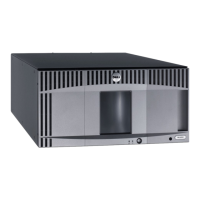<keyAlias1>cert1</keyAlias1> - keyAlias2
<dateTime>Tue Feb 20 09:18:07 CST 2007</dateTime> - creation date
</KeyUsageEvent>
Note: For LTO 4 and LTO 5 drives there will only be <keyAlias1></keyAlias1>
record and DKi will be recorded.
Querying the Metadata XML File
Use the EKMDataParser tool to query the metadata file. This tool parses the XML
file using Document Object Model (DOM) techniques and cannot be run from the
Encryption Key Manager command line interface. It is invoked as follows:
java com.ibm.keymanager.tools.EKMDataParser -filename
full_path_to_metadata_file {-volser volser | -keyalias alias}
metadata_path
This is the same directory path specified for the metadata file in
Audit.metadata.file.name in the KeyManagerConfig.properties file.
-filename
filename is required and must be the name of the XML metadata file. This will
usually match the name specified in the Audit.metadata.file.name property in
the KeyManagerConfig.properties file.
-volser
The volume serial number of the tape cartridge you are searching for in the
XML file. Either -volser or -keyalias must be specified.
-keyalias
The key label or alias you are searching for in the XML file. Either -volser or
-keyalias must be specified.
Example
Assuming that the metadata filename property (Audit.metadata.file.name) in
KeyManagerConfig.properties is set to a value of metadata and the file is located
in your local directory where the Encryption Key Manager runs, the following
command would filter (display) only the XML records related to volser 72448:
<jvm_path>/bin/java com.ibm.keymanager.tools.EKMDataParser -filename metadata -volser 72448
The output would be formatted as follows:
Table 8-1. Metadata Query Output Format
keyalias1 keyalias2 volSer dateTime driveSSN dki
cert1 cert2 72448 Wed Mar 14 10:31:32 CDT 2007 FVTDRIVE0004
Recovering from a Corrupted Metadata File
The Encryption Key Manager metadata file can become corrupted if the Encryption
Key Manager is improperly shutdown or the system where the Encryption Key
Manager is running crashes. Improper editing or modification of the metadata file
can also corrupt it. The corruption will go unnoticed until the EKMDataParser
parses the metadata file. The EKMDataParser may fail with an error similar to the
following:
8-2 Dell Encryption Key Mgr User's Guide
|
